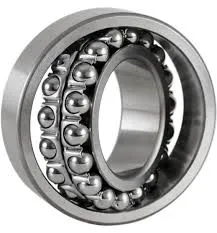
Nov . 07, 2024 17:05 Back to list
Deep Groove Ball Bearing Specifications and Selection Guide for Optimal Performance
Understanding Deep Groove Ball Bearing Specifications
Deep groove ball bearings are one of the most commonly used types of bearings in various industries due to their versatility and robustness. They can support both radial and axial loads, which makes them ideal for a wide array of applications, from electric motors to automotive components. In this article, we will delve into the specifications and important attributes of deep groove ball bearings, providing a clearer understanding for engineers, designers, and maintenance professionals.
What is a Deep Groove Ball Bearing?
A deep groove ball bearing consists of an outer race, an inner race, a set of balls, and a cage to keep the balls evenly spaced. The design allows for the accommodation of radial and axial loads in both directions. The deep groove refers to the raceway's design, which is deeper than that in standard ball bearings, enabling it to carry heavier loads.
Key Specifications
1. Dimensions The primary specifications for deep groove ball bearings include the inner diameter (ID), outer diameter (OD), and width (B). These measurements are crucial for ensuring compatibility with the shaft and housing. Standard dimensions are defined in various international standards like ISO, and it's essential to select the correct size to guarantee optimal performance.
2. Load Ratings Bearings have both dynamic and static load ratings, which indicate the maximum load they can withstand during operation and at rest, respectively. The dynamic load rating is essential for determining the bearing’s life expectancy under load, expressed in terms of L10 life, which indicates the number of revolutions at which 90% of bearings will still be operational.
deep groove ball bearing specification

3. Materials Most deep groove ball bearings are made from high-carbon chromium steel, which provides excellent hardness and wear resistance. Some applications may require stainless steel bearings for improved corrosion resistance, while polymer materials can be used in light-duty applications where weight and resistance to harsh environments are crucial.
4. Speed Ratings The maximum operating speed of a bearing is another critical specification. It is typically denoted as a “n” designation (in RPM). Engineers must adhere to these speed ratings to prevent excessive heat generation and eventual bearing failure.
5. Clearance and Tolerance Deep groove ball bearings come with various clearance options, ranging from C0 (normal clearance) to C3 and C4 (increased clearance). The selection depends on the application, temperature variations, and load conditions. Proper tolerance ensures that the bearings fit precisely in their housings, minimizing vibration and wear.
6. Seal and Shield Types Many deep groove ball bearings feature seals or shields designed to protect the bearing from contaminants. Sealed bearings are ideal for applications involving dirt and moisture, while shielded bearings offer a level of protection with lower drag. It's crucial to choose the right configuration based on the operating environment.
7. Grease and Lubrication Deep groove ball bearings are typically pre-lubricated with grease, but in some applications, oil lubrication may be more suitable. The choice of lubricant will affect the bearing’s speed, load capacity, and operating temperature range. Manufacturers usually provide guidance on recommended lubricants for their bearings.
Conclusion
Deep groove ball bearings are foundational components in mechanical systems, supporting a myriad of applications across industries. Understanding their specifications is crucial for selecting the right bearing for a specific task. By paying attention to dimensions, load ratings, materials, speed ratings, clearances, seals, and lubrication options, engineers and technicians can ensure optimal bearing performance, efficiency, and longevity. When in doubt, consulting technical data sheets or reaching out to manufacturers can provide additional insights and guidance in making the right selections for your engineering needs.
Latest news
-
Durable Greenhouse Pillow Block Bearings for Reliable Ventilation
NewsAug.31,2025
-
Spherical Roller Bearings Applications: Heavy Duty, Self-Aligning
NewsAug.30,2025
-
Premium Deep Groove Ball Bearings | High Speed & Reliability
NewsAug.29,2025
-
Durable Scaffolding Clamps - Secure & Reliable Tube Connectors
NewsAug.28,2025
-
Common Failures in Thrust Ball Bearings and Solutions
NewsAug.22,2025
-
How Tapered Roller Bearings Can Take Shock Loads
NewsAug.22,2025
